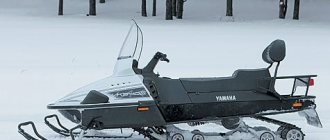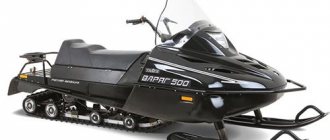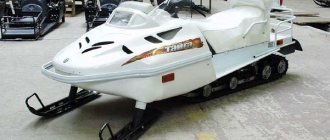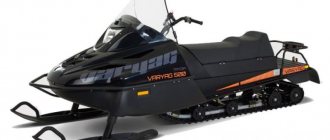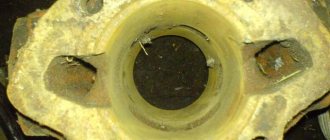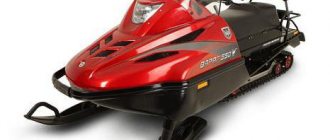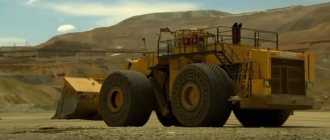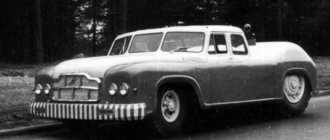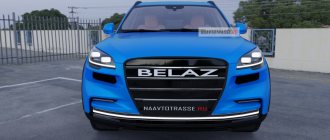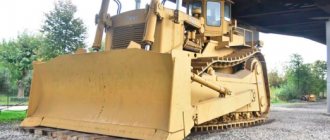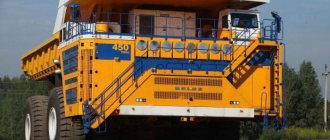"TAIGA" is one of the most common utilitarian and multifunctional snowmobiles in Russia. They started producing it in 1997. With it you can simply, comfortably and reliably get to the desired point, through the least snowy centers of Russia or through the snow-covered tundra.
In this technique, the main thing is not speed, but reliable riding in any harsh places. It gained its trust and reliability after some models were put into service with the Russian army. The Taiga brand has many models in its assortment.
Double: “Varyag”, “TAYGA PATRUL”.
Light single-seat: “RYBINKA”, “TIKSY 250”.
All models with different characteristics, build quality and reliability. And those who know about these snowmobiles first-hand will tell you about all this.
Snowmobile Taiga - owner reviews
“I’ll say right away that the impressions of the Taiga snowmobile are not pleasant. I first met him on a weekend trip with my family and friends. Previously I tried the Buran model and was also not satisfied with its single-lane design. Always falls to the side. Because of this, from the beginning I asked the organizers of the race what kind of snowmobile I would have, and they offered me a two-lane “Taiga”, and I agreed. Due to its powerful engine, it reached speeds of up to 60 km/h. And of course the snowmobile will be stable. And even on the sharpest turns, the runner rises slightly from the surface. A good plus for me is the double seater. "Taiga" is good for an ordinary winter trip through the forest. But my disadvantages to it are the lack of speed, the smell of fuel and poor traction. Well, this is my personal opinion, but for beginners they are not noticeable.”
Grade:
Dmitriy
“If they asked me what I thought about the Taiga,” I would not be able to say anything good, no matter how domestic this device was. In general, my wife's brother bought it and a week later the first breakdown occurred. The next day, we went to the sellers. And they, of course, were shocked. According to them, they have not sold a single defective snowmobile, high-quality product, etc., and this is the first such one to come across. Maybe that's how it is. In order not to repeat the mistake of my relative, be sure to take a ride on your future purchase. This is my story about this snowmobile.” Grade:
Nikolai
“As soon as the first snow fell, my family and I, on the very first weekend, went to actively relax at the ski resort. My husband suggested we go snowmobiling and chose it himself. His choice was "Taiga". The two-seater beast-machine with two runners held very firmly on the snowy road and confidently took turns. But there were some hiccups. “Ride like a breeze”, you can call the speed of this snowmobile 60 km/h. We were so engrossed in driving through the forest that we rode all day. Everyone in the family has great emotions. For winter, active recreation, I recommend it! Grade:
Julia
Specifications
Let's take as an example the Taiga model. Classic". The two-seater vehicle, with a width of 1020 cm and a length without skis of 2810, has wide tracks (600 mm), low gear and reverse gear, allowing you to easily transport heavy loads. The maximum speed of up to 100 km/h will allow you to feel that very breeze.
- Dry weight 265.
- Engine with a volume of 500 cubic meters.
- Two-speed gearbox.
- Fuel tank capacity is 35 liters.
- Recommended fuel is AI-80.
- Pneumohydraulic shock absorbers provide a soft ride.
The lineup
The model range includes:
- Varangian;
- Patrol;
- ST 500D;
- Attack;
- Vector.
All models differ in technical parameters.
Varangian
Description and technical indicators:
| Motor model | RMZ-550 |
| Fuel fluid container | 55.3 l |
| Number of cylindrical elements | 2 |
| Engine power | 55 l. With. |
| Power unit type | Push-pull |
| Cylinder diameter | 7.6 cm |
| Piston stroke | 6.1 cm |
| Fuel system type | Two-carburetor |
| Carburetor model | Mikuni |
| Cooling system type | Air |
| Exhaust system | Silencer equipped with a resonator |
| Intake system | Reed valve |
| Lubrication system | Combined |
| Maximum driving speed | 80 km/h |
| Transmission of the snowmobile Taiga Varyag-500 | CVT SVT |
| Brake type | Hydraulic |
| Engine starting system | Manual and electric starter |
| Ignition | Capacitive, programmable |
| Reverse | Eat |
| headlight | Halogen |
| Speedometer | Eat |
| Front suspension type | Telescopic |
| Front suspension travel | 10.5 cm |
| Rear suspension type | Slimy |
| Ski track | 0.9 m |
| Track belt | 9.94*0.5*0.022 m |
| Rear suspension travel | 19 cm |
Patrol
Parameters and performance of the snowmobile Taiga Patrol 800 SWT:
| Highest speed | 105 km/h |
| Track Parameters | 3.93*0.6*0.022 m |
| Front suspension | Reinforced, telescopic, with increased stroke |
| Travel of suspension mechanisms | Front - 15 cm Rear - 19 cm |
| Rear suspension | Customizable |
| Shock absorber | Monotube |
| Gearbox type | Two-stage |
| Reverse | Eat |
| Number of speeds | 2 |
| Brake system type | Disc, hydraulic |
| Engine starting system | Electric |
| headlight | Halogen |
| Ignition mechanism | Multipoint fuel injection |
| Speedometer | Eat |
| Cylinder arrangement | V-shaped |
| Cooling system | Dual-circuit |
| Motor type | Four stroke |
| Power | 60 l. With. |
| Weight | 350 kg |
| Ski track | 0.96 m |
| Dimensions | 2.99*1.13*1.4 m |
Performance indicators of the Taiga Patrol 550 SWT:
| Power unit | RMZ-550 |
| Power | 55 l. With. |
| Motor type | Push-pull |
| Diameter of cylindrical elements | 7.6 cm |
| Piston stroke | 6.1 cm |
| Fuel device | Two-carburetor |
| Fuel cooling type | Air |
| Intake system | Muffler with resonator |
| Travel speed | 80 km/h |
| Starting system | Electric starter |
| Reverse | Eat |
| Ignition | Capacitive |
ST-500D
Technical parameters of the Taiga ST-500D model:
| Hanging mechanism | Telescopic |
| Rear suspension | Slimy |
| Number of shock absorbers on the front suspension | 2 |
| Mover | Crawler, with front drive sprockets |
| Number of tracks | 1 |
| Tension device | Screw |
| Track type | Reinforced, material - rubber + fabric |
| Track Length | 3.93 m |
| Track width | 0.5 m |
| Transmission model | Variable speed drive |
| Number of gears | 4 |
| Reverse | Eat |
| Brakes | Disc, adjustable |
| Brake drive | Hydraulic |
| Starting the power unit | Manual, with electric starter |
| Power supply system for electrical appliances | Carburetor |
| Ignition system | Ducati |
| Lubrication mechanism | Combined (oil + gasoline) |
| Fuel tank volume | 35 l |
| Number of seats | 2 |
| Travel speed | 80 km/h |
| Heated control levers | Eat |
| Windshield | Eat |
| Weight | 280 kg |
| Dimensions | 3.21*1.02*0.96 m |
Also on the market is the Taiga Ataka 551 I snowmobile model.
Attack
Technical indicators of this modification:
| Power unit model | RMZ-551 |
| Fuel tank capacity | 55.3 l |
| Number of cylinders | 2 |
| Motor power | 60 l. With. |
| Cylinder diameter | 7.6 cm |
| Piston stroke | 6.1 cm |
| Fuel device | Carburetor |
| Number of carburetors | 2 |
| engine's type | Push-pull |
| Carburetor type | Float |
| Cooling system | Liquid |
| Release mechanism | Muffler with resonator |
| Intake mechanism | Reed valve |
| Mechanism lubrication system | Separate |
| Highest speed | 100 km/h |
| Gearbox model | Variable speed drive |
| Number of speed modes | 4 |
| Reverse | Eat |
| Brakes model Taiga Attack 2 | Disc, hydraulic |
| Engine starting mechanism | Electric starter |
| Ignition | Capacitive, programmable |
| Heated grips | Eat |
| headlight | 55/60, halogen |
| Front suspension | Lever, stroke - 20.5 cm |
| Shock absorber | Twin-pipe, hydropneumatic |
| Weight | 320 kg |
| Track Dimensions | 3.93*0.5*0.022 m |
| Rear suspension travel | 37 cm |
| Ski track | 0.99 m |
Vector
Specifications:
| Motor model | RMZ-551 |
| Fuel fluid container | 55.5 l |
| Number of cylindrical elements | 2 |
| Engine power | 67 l. With. |
| Power unit type | Push-pull |
| Cylinder diameter | 7.6 cm |
| Piston stroke | 6 cm |
| Fuel system type | Two-carburetor |
| Carburetor model | Mikuni |
| Cooling system type | Air |
| Exhaust system | Silencer equipped with a resonator |
| Intake system | Reed valve |
| Lubrication system | Separate |
| Maximum driving speed | 105 km/h |
| Transmission | Variable speed drive |
| Brake type | Hydraulic |
| Engine starting system | Manual and electric starter |
| Ignition | Capacitive, programmable |
| Reverse | Eat |
| headlight | Halogen |
| Speedometer | Eat |
| Front suspension type | Lever |
| Front suspension travel | 22.5 cm |
| Rear suspension type | Slimy |
| Ski track | 1.1 m |
| Track belt | 3.96-0.5*0.03 m |
| Number of seats | 2 |
| Drawer sizes | 3.35*1.19*1.2 m |
| Rear suspension travel | 38.5 cm |
Less common models
Parameters of the Bars-850 model:
| Hanging device | Telescopic |
| Rear suspension | Slimy |
| Number of shock absorbers on the front suspension | 2 |
| Engine | Crawler, with front drive sprockets |
| Number of tracks | 1 |
| Tension device | Screw |
| Type of caterpillar | Reinforced, material - rubber + fabric |
| Track Length | 3.93 m |
| Track width | 0.6 m |
| Transmission model | Variable speed drive |
| Number of gears | 4 |
| Reverse | Eat |
| Brakes | Disc, adjustable |
| Brake drive | Hydraulic |
| Starting the power unit | Manual, with electric starter |
| Power supply system for electrical appliances | Carburetor |
| Ignition system | Ducati |
| Lubrication mechanism | Separated |
| Fuel tank volume | 50 l |
| Number of seats | 1 |
| Travel speed | 105 km/h |
| Heated control levers | Eat |
| Windshield | Eat |
| Weight | 330 kg |
| Ski track width | 0.96 m |
| Box dimensions | 3.08*1.19*1.2 m |
| Suspension travel | Front - 15 cm Rear - 38.5 cm |
| Dimensions | 2.95*1.15*1.46 m |
Selecting a snowmobile
They come in different types: Utilitarian, Tourist, Sports, Children's, Mountain. Tourist - designed for a quiet ride through the forest, for example with family. Sports ones, on the contrary, are for those who like great speed and maneuverability. For children, it is already clear that for growing up fans of this type of transport.
Mountain - for driving on bumpy roads and for jumping, springboards and so on. Utilitarian - have ideal characteristics for overcoming deep snow. Long and wide track, low gear. We will tell you about this type of snowmobile, namely the “Taiga” model.
Why the utilitarian “Taiga”?
These snowmobiles, one might say, are “workhorses”, which are loved both by fishermen and hunters, and by residents of those places where it is practically impossible to get through by regular transport. Another important feature is to transport goods.
That's why these cars are equipped with low gear. It also makes you more confident off-road. This device belongs to two-stroke engines. The advantages of such engines are ease of control and ease of repair. These motors are simple, reliable and unpretentious.
Engine
The Taiga Varyag 550 snowmobile is equipped with a power plant of its own production, namely a two-stroke engine of the RMZ-550 brand. The block of this unit contains two cylinders, the total volume of which is 0.553 liters. In the basic configuration, this engine is equipped with one Mikuni model carburetor. The rated output power of the RMZ-550 reaches 36.78 kilowatts, which translates to 50 horsepower. The cooling system of this unit is air type. Starting is carried out using an electric starter, but the engine can also be started manually. The programmable ignition system of the DUCATI CDI model is used. It is worth noting that the manufacturer often uses this ignition system in its products, as it ensures smooth and stable engine operation in all operating modes.
The engine has high traction characteristics and reliability. According to the manufacturer, this unit is designed for a fairly long service life, and serious breakdowns occur extremely rarely. In terms of maintenance, the RMZ-550 is very simple and unpretentious, and all spare parts are widespread and affordable.
Self-assembly
A snowmobile is an excellent option for active winter recreation. But their prices are rising rapidly. If you are deprived of ingenuity and engineering abilities, then it will not be difficult for you to make your own snowmobile. Before you start drawing up drawings, think carefully about what you would construct your equipment from.
The main part of your car is the engine. The best option would be a walk-behind tractor. Why him? First, in the winter, and this rather powerful engine that sits idle in your barn. And when spring comes and the snow melts, he can safely remove the walk-behind tractor and continue to use it for its main purposes. Assembly Needs: Pipe bender, welding, additional parts purchased at the store.
So, let's start assembling. Our device will consist of two main parts: the driven part and the driving part. The driven part is the steering wheel and shock absorbers. Drive frame, drive, power frame. Now we need to determine which parts we will make ourselves and which ones we will buy in the store. You can make the frame yourself from a metal pipe and shape it using a pipe bender. All parts are attached to the frame using a welding machine.
And to the finished frame, we weld a bracket for the engine, steering wheel, skis and seat. Our snowmobile will be tracked, which will allow our vehicle to have strong grip on the road and high maneuverability. We will also make the caterpillar ourselves, having imagination, water pipes and a conveyor belt.
More detailed information in this video:
Do I need a license and registration for a snowmobile?
Without conditional rights are needed. Snowmobiles are classified as special equipment. To obtain the right to drive this type of transport (as well as an ATV), you need a category A driver's license. This category includes: off-road motor vehicles. This category can be obtained from the age of 16.
The fee for the license is 500 rubles. Snowmobiles must undergo mandatory registration within ten days at Gostekhnadzor, otherwise you will face a fine of 1,000 to 10,000 rubles. The cost of insurance is 23,500. This equipment can only be stopped by Gostekhnadzor employees, but not by traffic police inspectors.
But MTPL insurance is not needed. New snowmobiles that are less than a year old do not need to undergo technical inspection. And the technical inspection was completed by Gostekhnadzor without inspection. But for owners of equipment that is more than a year old, a technical inspection is required once a year. The cost of insurance is 400 rubles. Picture!
Price
The Taiga Varyag 550 snowmobile belongs to the equipment of the inexpensive price segment. The cost of a new one starts from 320 thousand rubles and reaches 380 thousand Russian rubles. In its class, this snowmobile is the most practical and powerful, and it can also compete with imported models of snowmobiles a class higher. The cost directly depends on factors such as year of production and equipment. A used car will cost in the range from 250 thousand rubles to 300 thousand Russian rubles. In this case, the price also fluctuates taking into account the year of manufacture of the snowmobile, technical condition and its total mileage.
Analogues of the Taiga snowmobile
This brand has very few analogues, since “Taiga” conquered the Russian market and became popular due to its rare assembly and unusual characteristics. Yamaha Viking can easily compete with it . The Russian snowmobile, after improvements, has improved suspension, becoming softer and smoother.
With these changes, the Russian brand has moved closer to top European brands. Russian Mechanics has finally started making good, competitive cars. But many users do not agree with this and call domestic cars, in comparison with their European counterparts, our snowmobiles “scrap metal”. It is very difficult to compare Taiga and Yamaha. After all, “Yamaha has conquered almost the entire world market, and “Russian Mechanics” is rarely found abroad.
Another similar competitor is the STELS 800 Wolverine . With a two-cylinder, 4-stroke engine, 800 cc/cm, has 67 horses. There is one drawback - it is very heavy! But at the same time it has excellent traction characteristics, like the Taiga. It consumes 20 liters per 100 km, which is not bad by snowmobile standards.
The track width is 600 mm, the length is almost 4 meters, and this is rare for utilitarian snowmobiles. The track toe height is only 22 mm, which is a disadvantage for driving in deep snow. The windshield, a rather strange shape, after 60 km/h, begins to bend from the air flow, but it is impossible to break it.
Comparison of Viking and Varyag snowmobiles
In terms of driving performance, power plant characteristics, handling, comfort and ergonomics, the Viking and Varyag are absolutely adequate to their retail prices.
The Japanese car is certainly a reliable machine. True, if something breaks in it, then with a high degree of probability the repair can take 2-3 weeks, since the necessary spare parts, to put it mildly, are not always available at the dealer. And, definitely, the process of restoring equipment will force the owner to incur significant financial losses. What do you want? This is a foreign car! The Rybinsk snowmobile is good for everyone, but not fully developed ergonomics, not as high as the “Japanese”, the level of pilot comfort, rather weak suspension and too noisy engine operation do not allow me to put the “Varyag” on the same step of the pedestal with the Yamaha VK540 III. Although, if reviews from real users confirm the high quality and reliability of the device declared by the manufacturer, then those who did not agree with my conclusions will have a good reason... no, not to hit me in the teeth, but to recommend reconsidering my position. POWER UNITS Both snowmobiles are equipped with two-stroke air-cooled engines. The VK540 III engine is equipped with a separate lubrication system - the owner of this machine is completely relieved of the obligation to regularly practice alchemy by mixing fuel with oil. It’s a pity, but when refueling the Varyag you will have to “chemicalize” it the old fashioned way. However, do not forget that in particularly severe frosts it is recommended to drop a little oil into the Viking’s fuel tank, otherwise the oil pump may become depressed and the engine will begin to experience oil starvation. Viking engine power is 46 hp. With. On paper, the Varyag engine has four more horses, but in reality the dynamics of these snowmobiles are identical. True, the Viking, in my opinion, has a little more traction at the bottom. And on “powdery” roads, the Japanese car drives more confidently, without the heart-rending “screams” of the engine and much smoother. But on a packed straight line and under two riders, both snowmobiles reach their honest maximum speed of 80 km/h. One of the most noticeable differences between the engines is that the Varyag engine is much louder, and this is annoying. In addition, according to the readings of the mechanical fuel level control devices (by the way, the Varyag has it more modern and is built into the gas tank cap - on the Viking the control occurs through a transparent fuel tube), the Japanese car consumes less fuel than the Rybinsk device. And, I note, the already “tested” Varyag took part in the test.
TRANSMISSION High and low gears, reverse, neutral - a standard arsenal of transmission operating modes for utilitarian snowmobiles. The functioning and control algorithm of the Viking transmission is an order of magnitude better and more convenient than that of a domestic car. But on the “Varyag” you are allowed to jump from first gear to second when the snowmobile is moving: in a lower gear, you pulled a loaded trailer from its place, accelerated to 40 km/h and switched to second. It’s much more pleasant to drive this way, and it also uses less gasoline. This trick will not work with the “Japanese”: according to the instructions, to switch from low to high and back, you must stop. According to him, he received a seriously redesigned and improved variator. Especially for this model, a new centrifugal governor and driven pulley were developed to improve the acceleration dynamics of the snowmobile and reduce fuel consumption, and an increased safety margin was built into the design of the centrifugal governor.
HANDLING AND SUSPENSIONS The Viking suspensions are more energy-intensive, their travel is greater than that of the Varyag suspensions. In addition, the “stern” of the VK540 III is equipped with two shock absorbers - versus one for the Varyag. Jumping on utilitarian snowmobiles is blasphemy (I love my job!). The brainchild of the descendants of samurai passed the test with dignity: without plaintive sobs of plastic and protest sounds of “broken” shock absorbers. The product of the heirs of the barge haulers (Rybinsk used to be a city of barge haulers) also turned out to be a “tough nut to crack”: nothing flew off or squeaked on landings, but the harsh sound of the shock absorbers working all the way clearly indicated that it was time to stop jumping. The tracks of the vehicles are almost identical; in terms of maneuverability and controllability, the Varyag and the Viking are twin brothers. The only thing is that the Japanese car has a 60 mm wider ski track, which makes the VK540 III more stable when driving over uneven surfaces or when driving at high speed. “Varyag” demonstrated better maneuverability on the “crossroads”: due to the smaller track of the skis and less weight (the domestic snowmobile is 8 kg lighter than its counterpart), it is more willing to fall into deep slopes on “powder”, which means it is easier to navigate on it. a route between the trees and a way to get out of the ravine that got in the way.
ERGONOMICS AND COMFORT There are no options here: Viking is the clear favorite. Although it was written above that on a domestic snowmobile you can change gears on the fly, believe me, it’s not so easy to do this with your left hand if you’re not used to it. Now pay attention to the shape of the handlebars and their height. The VK540 III has a higher steering wheel, and its handles are turned towards the driver and lowered down. The “Varyagov” steering column is lower, the handles are oriented directly towards the driver. Taking into account the low seating position of the pilot on both snowmobiles, the “Japanese” is more comfortable to drive: the hands get less tired, and it is more comfortable to steer in any riding style - both at an active and at a calm pace. By the way, about passengers. According to the photographer accompanying me, the Viking seat was more comfortable and safer, since there was no need to reach for the handrails, my hands did not freeze, the seat was soft and there was more space. On the Varyag, the handles for the passenger are located lower, there is open steel in the grip areas, the seat itself is stiffer and at the same time 4–5 cm shorter. However, these small miscalculations in ergonomics are partly compensated by more spacious underseat space and a larger open luggage platform.
QUALITY AND RELIABILITY Everything is clear about the reliability of the Viking - an unconditionally high-quality machine, time-tested. It's no joke, it will soon be almost 20 years since the appearance of the first generation of these snowmobiles! Let me remind you that the modification VK540 III (third generation) went on sale in 2001. For reference: the first “Taiga” was released somewhere in 1998–1999... So another question is who “copied” the concept of the “people’s” snowmobile from whom! Just kidding, let's digress. What about the quality and reliability of Varyag? Russian Mechanics understands perfectly well that after the enthusiastic reaction to the unprecedentedly affordable price tag for the Varyag, a potential buyer will definitely inquire about issues of quality and reliability... And the answers are already ready! I will cite just a few of them: “the hood is made using a new vacuum molding technology, the material used is ABS plastic, which provides elasticity and has increased impact resistance”; “for better engine cooling, air ducts are used to supply cold air directly into the cooling system, which will prevent the engine from overheating”; “The RMZ-550 power plant provides confident traction under any driving conditions, with a power of 50 hp. With. with the simplicity of a single-carburetor system, it was achieved by increasing the engine volume from 500 to 550 cm3... The highlight of the Varyag promotion program is the “warranty period with routine maintenance: two years or 3000 km, spare parts and service can be obtained in more than 140 dealership centers of the manufacturer." Agree, serious arguments
Yamaha VK540 III 2010, 525 cc, 46 hp, 288 kg, 299 thousand rubles. reliable, like an old friend everything is at hand nothing can break the comfort of a home sofa the trunk is too small the exhaust is death to environmentalists archaic design
Taiga-Varyag 550 2010, 553 cc, 50 hp, 280 kg, 199 thousand rubles. modern appearance spare parts always available excellent maneuverability tempting price ergonomics require improvement reliability is an open question suspensions lack energy intensity
Riding a Yamaha VK540III
Descent from the mountain to Taiga-Varyag 550
